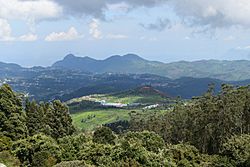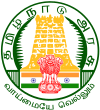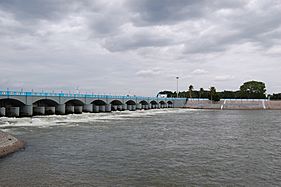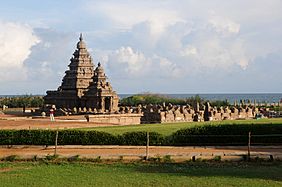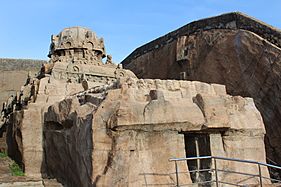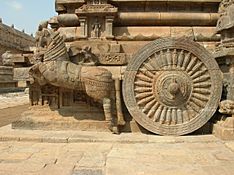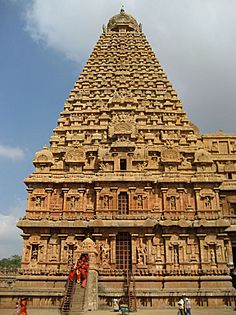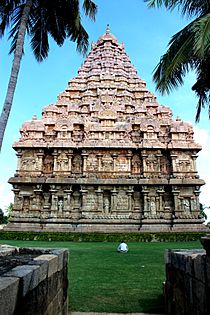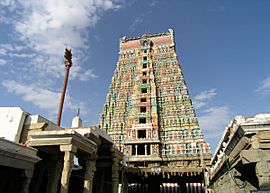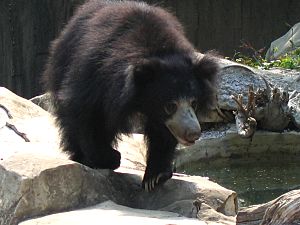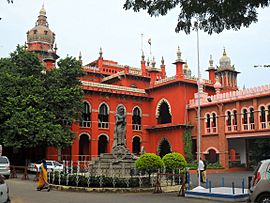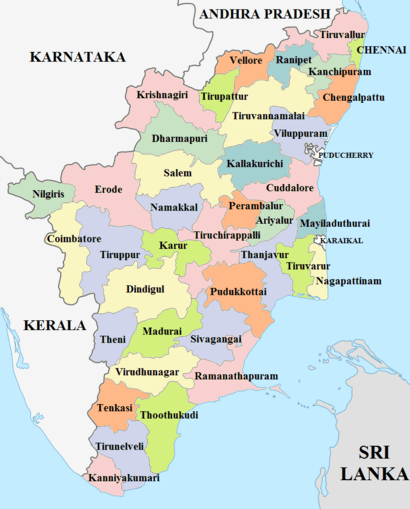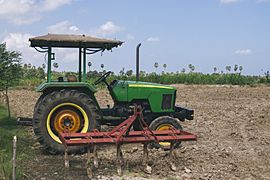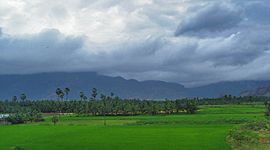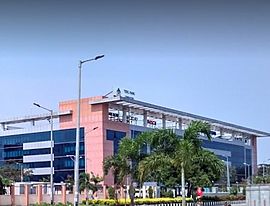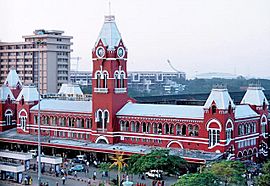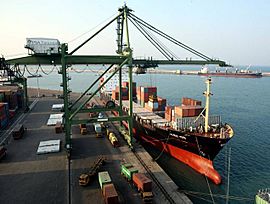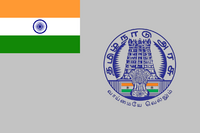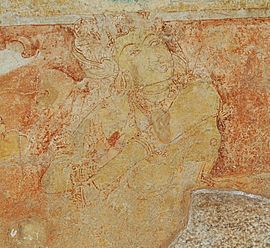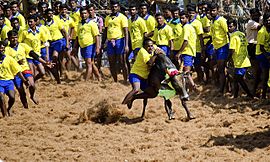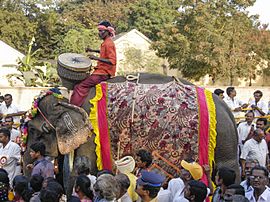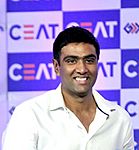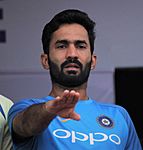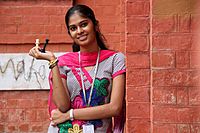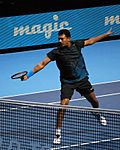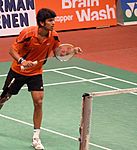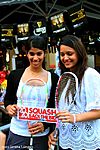Tamil Nadu facts for kids
Quick facts for kids
Tamil Nadu
|
|||||||||||||||||||||||||||
|---|---|---|---|---|---|---|---|---|---|---|---|---|---|---|---|---|---|---|---|---|---|---|---|---|---|---|---|
|
From top, left to right:
Brihadisvara Temple, Shore Temple, Ranganathaswamy Temple, Nilgiri Mountains, Hogenakkal Falls and Thiruvalluvar Statue |
|||||||||||||||||||||||||||
|
|||||||||||||||||||||||||||
| Motto(s):
Vāymaiyē vellum
(Truth alone triumphs) |
|||||||||||||||||||||||||||
| Anthem: "Tamil Thai Valthu" (Invocation to Mother Tamil) |
|||||||||||||||||||||||||||

Location of Tamil Nadu in India
|
|||||||||||||||||||||||||||
| Country | |||||||||||||||||||||||||||
| Formation | 26 January 1950 | ||||||||||||||||||||||||||
| Capital and Largest City |
Chennai | ||||||||||||||||||||||||||
| Largest Metro | Greater Chennai Metropolitan Area | ||||||||||||||||||||||||||
| Districts | 38 | ||||||||||||||||||||||||||
| Government | |||||||||||||||||||||||||||
| • Body | Government of Tamil Nadu | ||||||||||||||||||||||||||
| Area | |||||||||||||||||||||||||||
| • Total | 130,058 km2 (50,216 sq mi) | ||||||||||||||||||||||||||
| Area rank | 10th | ||||||||||||||||||||||||||
| Population
(2011)
|
|||||||||||||||||||||||||||
| • Total | 72,147,030 | ||||||||||||||||||||||||||
| • Rank | 6th | ||||||||||||||||||||||||||
| • Density | 554.7297/km2 (1,436.743/sq mi) | ||||||||||||||||||||||||||
| Demonym(s) | |||||||||||||||||||||||||||
| GDP (2020–21) | |||||||||||||||||||||||||||
| • Total | |||||||||||||||||||||||||||
| • Per capita | |||||||||||||||||||||||||||
| Languages | |||||||||||||||||||||||||||
| • Official | Tamil | ||||||||||||||||||||||||||
| • Additional official | English | ||||||||||||||||||||||||||
| Time zone | UTC+05:30 (IST) | ||||||||||||||||||||||||||
| ISO 3166 code | IN-TN | ||||||||||||||||||||||||||
| Vehicle registration | TN | ||||||||||||||||||||||||||
| HDI (2018) | high · 11th |
||||||||||||||||||||||||||
| Literacy (2017) | |||||||||||||||||||||||||||
| Sex ratio (2019) | 996 ♀/1000 ♂ | ||||||||||||||||||||||||||
| Coastline | 1,076 km (669 mi) | ||||||||||||||||||||||||||
|
|||||||||||||||||||||||||||
| Jana Gana Mana is the national anthem, while Invocation to Mother Tamil is the state song/anthem. Established in 1773; Madras State was formed in 1950 and renamed as Tamil Nadu on 14 January 1969 |
|||||||||||||||||||||||||||
Tamil Nadu is a state located in southern India. Its capital and largest city is Chennai. Tamil Nadu is in the southernmost part of the Indian subcontinent. It shares borders with the union territory of Puducherry and the states of Kerala, Karnataka, and Andhra Pradesh. To its east is the Bay of Bengal, and to its south are the Gulf of Mannar, the Palk Strait, and the Indian Ocean. The state also has a maritime border with Sri Lanka.
This region was once ruled by powerful kingdoms like the Cheras, Cholas, and Pandyas. These rulers greatly influenced the area's food, culture, and buildings. Later, during British rule, Chennai (then called Madras) grew into a major city. Modern Tamil Nadu was formed in 1956. The state is home to many old buildings, religious sites, hill stations, and three World Heritage Sites.
Tamil Nadu is the tenth largest Indian state by area and the sixth largest by population. It is one of India's most urbanized and industrialized states. The economy of Tamil Nadu is the second largest in India. Its official language is Tamil, one of the oldest classical languages in the world.
Contents
Discovering Tamil Nadu's Past
Ancient Times: Early Humans and Settlements
Archaeological evidence shows that people have lived in this area for a very long time. In Attirampakkam, near Chennai, scientists found old stone tools. These tools suggest that human-like people lived here even before modern humans arrived from Africa.
A special stone axe with Indus script (writing from the ancient Indus Valley Civilization) was found in Sembian-Kandiyur. This was the first time Indus script was found in Tamil Nadu. It suggests that people in this region might have spoken a language similar to the Harappan language around 1500 BCE to 2000 BCE.
In Adichanallur, archaeologists found many clay pots containing human remains and ancient tools from 3,800 years ago. They also found early forms of Tamil Brahmi script. About 60% of all ancient writings found in India by the Archaeological Survey of India are from Tamil Nadu, and most are in the Tamil language. Recent digs in Keezhadi near Madurai show a large city from the 6th century BCE. Some pottery found there has writing that might connect the Indus Valley script to Tamil Brahmi.
The Sangam Period: Kingdoms and Literature
The early history of Tamil Nadu's people and rulers comes from Sangam literature. This period lasted for about 800 years, from 500 BCE to 300 CE. Recent findings at Alagankulam show it was an important trade port during this time.
Ancient Tamil Nadu had three main kingdoms, led by kings called Vendhar. These were the Cheras, Cholas, and Pandyas. They were known as the Moovendar, meaning "three crowned kings."
- The Cheras ruled the western part, which is now western Tamil Nadu and Kerala.
- The Pandyas controlled the south.
- The Cholas were based in the Kaveri delta and ruled northern Tamil Nadu.
These kings supported the creation of early Tamil literature. The oldest known work is the Tolkāppiyam, a book on Tamil grammar. Most Sangam literature talks about love and war. It gives us a peek into Tamil society back then. People traded a lot with other parts of the world, including the Romans and Han China. Spices, pearls, and silk were popular trade items.
After 300 CE, there was a quiet period in literature, possibly due to the Kalabhras who ruled much of Tamilkam. During their rule, important works like the Cilappatikaram and the Tirukkuṟaḷ by Valluvar were written. The Tirukkuṟaḷ is a collection of wise sayings about life and ethics, still highly respected today. Around 7th century CE, the Pandyas and Cholas took over from the Kalabhras.
Middle Kingdoms: Great Empires and Temples
-
Kallanai or Grand Anicut, an ancient dam built on the Kaveri River in Thanjavur district by Karikala Chola around the 2nd century CE
-
Shore Temple built by the Pallavas at Mamallapuram during the 8th century, now a UNESCO World Heritage Site
-
Vettuvan Koil, the unfinished temple is believed to have been built during the 8th century by Pandyas in Kalugumalai, a panchayat town in Thoothukudi district.
From the 4th to 8th centuries, the Pallava dynasty became powerful. They ruled parts of South India from their capital, Kanchipuram. Tamil architecture reached its peak under the Pallavas. The Shore Temple, a UNESCO World Heritage Site, was built by Narasimhavarman II.
Later, the Chola dynasty took over from the Pallavas in the 9th century. They were then replaced by the Pandyan Dynasty in the 13th century. The Pandyan capital, Madurai, was a major center. They traded widely, even with the Roman Empire. Marco Polo described the Pandyas as one of the richest empires. Temples like the Meenakshi Amman Temple in Madurai show the amazing Pandyan architecture.
The Mighty Chola Empire
In the 9th century, the Chola dynasty rose again under Vijayalaya Chola. He made Thanjavur the new Chola capital. Kings like Rajaraja Chola and his son Rajendra Chola made the Chola Empire very powerful. It stretched across South India, parts of Sri Lanka, and even reached Bengal.
Rajendra Chola's navy was so strong that it controlled coasts from Burma to Vietnam, including islands like the Andaman and Nicobar Islands and Sumatra. He built a new capital called Gangaikonda Cholapuram to celebrate his victory over the king of Bengal.
The Cholas were famous for building grand temples. The Brihadeshvara Temple in Thanjavur and the one in Gangaikonda Cholapuram are amazing examples. These, along with the Airavatesvara Temple in Darasuram, are known as the Great Living Chola Temples and are UNESCO World Heritage Sites.
- Great Living Chola Temples
-
The granite gopuram (tower) of Brihadisvara Temple, 1010 CE
-
The pyramidal structure above the sanctum at Brihadisvara Temple, Gangaikonda Cholapuram
-
Brihadisvara Temple Entrance Gopurams at Thanjavur
Vijayanagar and Nayak Rule
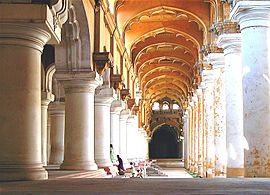
The Vijayanagara Empire, a Hindu empire, rose in southern India. It eventually conquered all of Tamil Nadu by around 1370 CE. After the Vijayanagara Empire weakened in the 16th century, many local rulers called Nayaks became independent.
The Nayaks of Madurai and Nayaks of Thanjavur were the most important. They rebuilt famous temples in Tamil Nadu, like the Meenakshi Temple.
European Influence and British Rule
In the 18th century, the political situation in Tamil Nadu changed a lot. European countries like the Dutch, Danes, British, and French started setting up trading posts along the coast. The British East India Company established a settlement in present-day Chennai in 1639. They built Fort St. George and a trading post.
The British and French often fought to control trade. The British eventually won, and the Nawab of the Carnatic gave them rights to collect taxes. This helped the British become very powerful in northern Tamil Nadu.
In the south, the British faced resistance from local chiefs called Palaiyakkarar (or 'polygars'). These conflicts led to the Polygar Wars.
- Puli Thevar was an early leader against British rule.
- Rani Velu Nachiyar was the first woman freedom fighter in India. She fought to avenge her husband's death.
- Kattabomman was another chief who fought the British in the First Polygar War.
- The Maruthu brothers and Dheeran Chinnamalai also led resistance movements.
After winning the Polygar Wars in 1801, the East India Company took control of most of southern India, forming the Madras Presidency.
Road to Independence
The Vellore Mutiny in 1806 was an early revolt by Indian soldiers against the British. It happened in Vellore and was a violent but short uprising.
Later, the British Raj took over direct control from the East India Company. In the 20th century, the Indian independence movement grew stronger. Many freedom fighters from Tamil Nadu, like V. O. Chidambaram Pillai and Bharatiyar, played important roles. Tamil people also formed a big part of the Indian National Army (INA), which fought against British rule. Lakshmi Sahgal from Tamil Nadu was a key leader in the INA.
In 1916, the Justice Party was formed to help non-Brahmins get more government jobs and education. They won elections and brought in reservations in 1926. Another important movement was the Self-Respect Movement led by E. V. Ramaswamy, known as Periyar. He promoted rational thinking and fought against the caste system and superstition.
After India gained independence in 1947, the Madras Presidency became Madras State. In 1969, Madras State was renamed Tamil Nadu, which means "Tamil country."
Geography and Climate
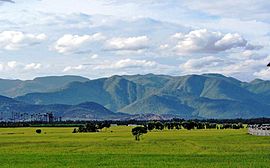
Tamil Nadu covers an area of 130,058 square kilometers (50,216 sq mi). It is the tenth-largest state in India. The Western Ghats mountains run along its western border, blocking much of the southwest monsoon rains. The eastern parts have fertile coastal plains. The central and south-central regions are drier.
Tamil Nadu has the country's third-longest coastline, about 906.9 km (563.5 mi) long. Pamban Island and other small islands form part of Ram Setu, a natural bridge that once connected India to Sri Lanka. The state was hit hard by the 2004 Indian Ocean tsunami, which caused many deaths.
Weather Patterns
Tamil Nadu relies heavily on monsoon rains. If the monsoons fail, the state can face droughts. The state has two main rainy seasons:
- The Southwest monsoon from June to September.
- The Northeast monsoon from October to December.
About 48% of the state's annual rainfall comes from the northeast monsoon. The state is divided into seven different climate zones, with the Kaveri Delta being the most fertile for farming.
Plants and Animals: Flora and Fauna
Tamil Nadu is home to about 2,000 species of wildlife. Its protected areas are safe homes for many large mammals. These include elephants, tigers, leopards, wild dogs, sloth bears, and gaurs. You can also find lion-tailed macaques, Nilgiri langurs, and Nilgiri tahrs.
The state has many birds, both resident and migratory. Examples are cormorants, darters, herons, egrets, and open-billed storks. Marine animals like dugongs, turtles, and dolphins live along the coast.
Tamil Nadu has a huge variety of plants, with 5,640 species. This is about one-third of all the plant species in India. Many of these are medicinal plants or unique species found only here. Common trees include the palmyra palm, eucalyptus, and teak.
Parks and Reserves for Wildlife
Tamil Nadu has many different natural environments, from rainforests to dry forests, beaches, and coral reefs. To protect this rich wildlife, there are many protected areas and biospheres.
- The Gulf of Mannar Biosphere Reserve protects a marine ecosystem with coral reefs and mangrove forests.
- The Nilgiri Biosphere Reserve is in the Western Ghats and Nilgiri Hills.
- The Agasthyamala Biosphere Reserve is in the southwest.
Tamil Nadu has five national parks: Anamalai, Mudumalai, Mukurithi, Gulf of Mannar, and Guindy (located in Chennai). The state also has tiger reserves like Sathyamangalam Tiger Reserve.
Governance and Administration
The Governor is the state's official head, while the Chief Minister leads the government. The Chief Justice of the Madras High Court is the head of the courts. The state is divided into 38 districts for administrative purposes.
Chennai, the capital, is the fourth-largest urban area in India. Tamil Nadu has 39 seats in the Lok Sabha (India's lower parliament) and 234 seats in its own Legislative Assembly. The state government serves for five years.
The Tamil Nadu Police Force is over 140 years old and is the fifth-largest state police force in India. It also has the highest number of women police officers in the country.
How the State is Divided
Tamil Nadu is divided into four main historical regions: Pallava Nadu, Chera Nadu, Chola Nadu, and Pandya Nadu. These are further split into 38 districts. Each district is managed by a District Collector.
Districts are then divided into smaller units called Taluks, which have Revenue blocks and many villages. Cities and towns are run by Municipal corporations and Municipalities. There are 15 city corporations, 152 municipalities, and 529 town panchayats. Rural areas have 31 district panchayats and many village panchayats.
Major Cities and Towns
Chennai is the most populated city in Tamil Nadu, with over 8.9 million people. Other large cities include Coimbatore, Madurai, Trichy, and Salem. Chennai is also the sixth-most populous city in India.
|
Largest cities or towns in Tamil Nadu
As of the 2011 Census |
||
|---|---|---|
| Rank | Pop. | |
| 1 | Chennai | 8,696,010 |
| 2 | Coimbatore | 2,151,466 |
| 3 | Madurai | 1,462,420 |
| 4 | Tiruchirappalli | 1,021,717 |
| 5 | Tiruppur | 962,982 |
| 6 | Salem | 919,150 |
| 7 | Erode | 521,776 |
| 8 | Vellore | 504,079 |
| 9 | Tirunelveli | 498,984 |
| 10 | Thoothukudi | 410,760 |
People and Languages
| Historical population | ||
|---|---|---|
| Year | Pop. | ±% |
| 1951 | 30,119,000 | — |
| 1961 | 33,687,000 | +11.8% |
| 1971 | 41,199,000 | +22.3% |
| 1981 | 48,408,000 | +17.5% |
| 1991 | 55,859,000 | +15.4% |
| 2001 | 62,406,000 | +11.7% |
| 2011 | 72,138,958 | +15.6% |
| Source:Census of India | ||
Tamil Nadu is the seventh most populated state in India. Almost half of its people (48.4%) live in cities. In 2011, the state had over 72 million people. For every 1,000 males, there were 995 females.
The literacy rate (people who can read and write) is 80.33%. Many people work in farming, while others are involved in household industries or other jobs.
Religions in Tamil Nadu
Most people in Tamil Nadu follow Hinduism. Christianity and Islam also have many followers in the state.
Languages Spoken
Tamil is the only official language of Tamil Nadu. English is also used for communication. Tamil was the first language in India to be recognized as a classical language of India. In 2011, about 88.37% of the state's population spoke Tamil as their first language. Other languages spoken include Telugu, Kannada, Urdu, and Malayalam.
Education in Tamil Nadu
Tamil Nadu is one of the most literate states in India. It has shown good progress in literacy between 2001 and 2011. A study found that Tamil Nadu has almost 100% enrollment in primary and upper primary schools.
The state has many educational institutions:
- 37 universities
- 552 engineering colleges
- 449 polytechnic colleges
- 566 arts and science colleges
- Over 34,000 elementary schools
Some famous colleges include Indian Institute of Technology Madras, Anna University, and Madras Medical College. Tamil Nadu has a high reservation (69%) in educational institutions for socially backward groups. The Midday Meal Scheme, which provides free meals to students, was first started in Tamil Nadu.
Economy and Industries
Tamil Nadu is India's most urbanized state, with 49% of its population living in cities. The service sector makes up 45% of the state's economy. Manufacturing contributes 34%, and agriculture accounts for 21%.
Farming and Agriculture
Historically, Tamil Nadu has been a farming state and is a major producer of farm products in India. It is the fifth-biggest producer of rice in India. The Kaveri delta region is often called the Rice Bowl of Tamil Nadu.
The state is the largest producer of bananas, turmeric, and flowers. It is also the second largest producer of mangoes, natural rubber, coconuts, and groundnuts. Tamil Nadu has the highest sugarcane yield per hectare in India.
Dr. M.S. Swaminathan, known as the "father of the Indian Green Revolution," was from Tamil Nadu. The Tamil Nadu Agricultural University helps develop new crop varieties and farming methods.
Tamil Nadu is a leader in livestock, poultry, and fisheries production. It has the second-largest number of poultry in India. The state also produces a lot of eggs. With its long coastline, Tamil Nadu is a major exporter of fish and seafood. Namakkal is a big center for egg production.
Textiles and Leather Goods
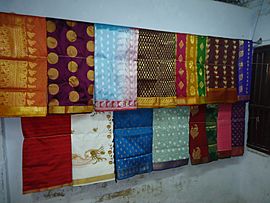
Tamil Nadu is a leading state in the textile industry. It has the largest spinning industry in India, accounting for almost 80% of the country's total capacity. The state produces 40% of India's yarn.
Tamil Nadu also handles 60% of India's leather tanning. It produces 38% of all leather footwear, clothing, and parts in the country.
Automobile Manufacturing
Tamil Nadu has attracted many investments in the automobile industry. It manufactures cars, railway coaches, tanks, tractors, motorcycles, and spare parts. Chennai is often called the Detroit of India.
Many big global car companies like BMW, Ford, Renault-Nissan, and Hyundai have manufacturing plants in Chennai. Indian companies like Ashok Leyland and TVS Motors are also based here.
Heavy Industries and Engineering
Tamil Nadu is one of the most industrialized states in India. Over 11% of India's largest companies have offices in Tamil Nadu.
Coimbatore is known as "the Pump City" because it supplies two-thirds of India's motors and pumps. The city is also a major exporter of wet grinders and auto components.
Electronics and Software
Electronics manufacturing is growing in Tamil Nadu. Many international companies like Nokia, Samsung, and Dell have chosen Chennai as their manufacturing hub in South Asia. They make products like circuit boards and mobile phones.
Tamil Nadu is the second-largest software exporter in India. Many big IT companies like Infosys, Wipro, Tata Consultancy Services, and Cognizant have offices here. Chennai has become known as the SaaS Capital of India for its software-as-a-service companies.
Transportation in Tamil Nadu
Road Network
Tamil Nadu has a huge road network connecting all parts of the state. There are 29 national highways, covering over 5,000 km (3,100 mi). The state is also part of the Golden Quadrilateral project, which links major Indian cities.
The state has a total road length of 167,000 km (104,000 mi). State-owned bus services, Tamil Nadu State Transport Corporation and State Express Transport Corporation, provide transport across the state.
Rail System
Tamil Nadu has a well-developed rail network, part of Southern Railway. Its headquarters are in Chennai. The state has over 5,952 km (3,698 mi) of railway tracks and 532 railway stations.
The Nilgiri Mountain Railway is a UNESCO World Heritage Site. It connects Ooty in the hills to Mettupalayam at the foothills. The old Pamban Bridge connects Rameswaram island to the mainland. It's an amazing engineering feat that can be raised to let ships pass.
Chennai also has a good suburban railway network and a Metro system. Major railway junctions include Chennai, Coimbatore, Madurai, and Tiruchirappalli.
Airports for Travel
Tamil Nadu has four international airports: Chennai International Airport, Coimbatore International Airport, Tiruchirapalli International Airport, and Madurai International Airport. It has the most international airports in India, along with Kerala.
There are also domestic airports in Salem, Thoothukudi Airport, and Vellore Airport. Chennai International Airport is a major aviation hub in South Asia. The state also has air bases for the Indian Air Force and naval air stations.
Seaports for Trade
Tamil Nadu has three major seaports: Chennai, Ennore, and Thoothukudi. There are also seven smaller ports. Chennai Port is an artificial harbor and a key port for handling containers. Ennore Port handles coal and ore.
Spaceport for Rockets
The Government of India is building a new rocket launch pad near Kulasekharapatnam in Thoothukudi district. The Indian Space Research Organization (ISRO) chose this location because it is close to the equator, which is good for launching rockets.
Culture and Traditions
Tamil Nadu is famous for its rich history of literature, art, music, and dance. These traditions are still very much alive today. The state is known for its ancient Hindu temples and the classical dance form of Bharata Natyam. Unique cultural features like Tanjore painting and Tamil architecture were developed here.
Tamil Literature: A Long History
Tamil written literature dates back over 2,300 years. The earliest period, Sangam literature, is one of the oldest Indian literatures. Ancient writings found on rocks and hero stones are from around the 3rd century BCE.
Most early Tamil works were poems. Sangam literature often talks about daily life, human relationships, and emotions. The Tolkāppiyam is the oldest known grammar book for the Tamil language. The Tirukkural by Tiruvalluvar is a famous collection of Tamil poetry.
In 1578, the Portuguese published the first Tamil book, making Tamil the first Indian language to be printed. During the Indian independence movement, many Tamil poets like Subramanya Bharathy wrote to inspire national spirit and social equality.
Festivals and Celebrations
Pongal is a major four-day harvest festival widely celebrated in Tamil Nadu. It is also called Tamizhar Thirunaal (festival of Tamils). The saying Thai Pirandhal Vazhi Pirakkum means "the birth of the month of Thai will open new opportunities."
- The first day, Bhogi Pongal, involves burning old items to mark new beginnings.
- The second day, Surya Pongal, is the main day, falling on January 14th or 15th.
- The third day, Maattu Pongal, thanks cattle for their help in farming. Jallikattu, a bull-taming sport, is a main event on this day.
- The final day, Kaanum Pongal, is for visiting family and friends.
The Tamil New Year is celebrated in mid-April. Aadi Perukku celebrates the rising water levels in the Kaveri river. Many villages and towns also have their own festivals for local gods, often related to the goddess Maariyamman. Other big festivals include Deepavali, Dasara, and Vinayaka Chathurthi. Muslims celebrate Eid ul-Fitr and Bakrid, while Christians celebrate Christmas and Easter. The Mahamagam festival, a bathing festival, happens every 12 years in Kumbakonam.
Delicious Tamil Cuisine
Tamil Nadu has unique food items. Thoothukudi is known for its macaroons, and Tirunelveli for its wheat Halva. Salem is famous for its mangoes. Madurai is the origin of the milk dessert Jigarthanda.
Common dishes across the state include Idlis, dosas, and sambar. Coffee and tea are popular drinks.
Film Industry
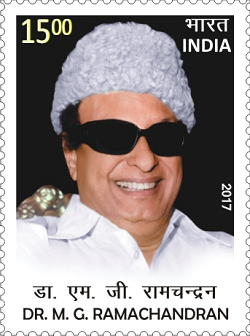
Tamil Nadu is home to the Tamil film industry, nicknamed "Kollywood." This name comes from Kodambakkam and Hollywood. Tamil cinema is one of the largest film industries in India.
Sports and Recreation
Kabbadi, also known as Sadugudu, is the state game of Tamil Nadu. Traditional sports include Silambam (martial arts with a bamboo staff), cockfight, Jallikattu (bull taming), and ox-wagon racing. These are often played during festivals.
Cricket is very popular. The M. A. Chidambaram Stadium in Chennai is an international cricket ground. Many famous cricketers like Ravichandran Ashwin and Dinesh Karthik are from Tamil Nadu. The Chennai Super Kings represent Chennai in the Indian Premier League.
- Notable sportspersons from Tamil Nadu
-
Adam Sinclair – Field hockey
-
P. V. Nandhidhaa – Chess Woman Grandmaster
-
Ramkumar Ramanathan – Tennis
-
Raj Bharath – Motorsport
-
Mariyappan Thangavelu (left most) – High jump
-
Ajay Jayaram – Badminton
-
Sharath Kamal (left) – Table tennis
-
Joshna Chinappa and Dipika Pallikal – Squash
Tennis is also popular, with international players like Ramesh Krishnan and Mahesh Bhupathi. The ATP Chennai Open tournament is held in Chennai every January.
Hockey is played in the state. Vasudevan Baskaran was the captain of the Indian team that won a gold medal in the 1980 Olympics. The Mayor Radhakrishnan Stadium in Chennai hosts international hockey events.
Tourism and Travel
Tamil Nadu's tourism industry is the largest in India. It attracts many visitors each year, both from India and other countries. The Tamil Nadu Tourism Development Corporation (TTDC) promotes tourism in the state.
The state has many grand Hindu temples built in Dravidian architecture. Several sites are UNESCO World Heritage Sites:
- The Nilgiri Mountain Railway
- The Brihadishwara Temple in Thanjavur
- The temples in Gangaikonda Cholapuram and Darasuram (part of the Great Chola Temples)
- The Shore Temple and other monuments in Mamallapuram
See also
 In Spanish: Tamil Nadu para niños
In Spanish: Tamil Nadu para niños





